Robert Cocking. A life given to a dream
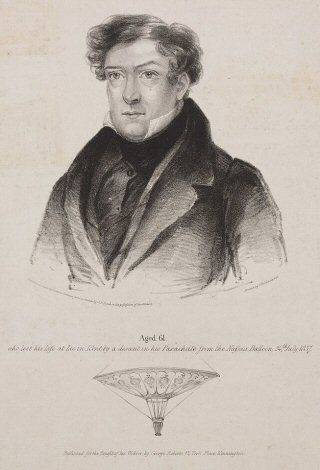 English artist Robert Cocking (1776 — 1837), the son of an Irish clergyman, was known in England not only for his watercolors, but also for his great educational work in the field of visual arts. His lectures always gathered a lot of people, according to the memoirs of contemporaries, were instructive, very interesting and witty. Being a very curious and energetic man, Cocking did not limit his circle of hobbies to one art. He was constantly busy with some business: he set up scientific experiments, invented the most incredible mechanisms that, as a rule, did not work, participated in discussions with scientists.
English artist Robert Cocking (1776 — 1837), the son of an Irish clergyman, was known in England not only for his watercolors, but also for his great educational work in the field of visual arts. His lectures always gathered a lot of people, according to the memoirs of contemporaries, were instructive, very interesting and witty. Being a very curious and energetic man, Cocking did not limit his circle of hobbies to one art. He was constantly busy with some business: he set up scientific experiments, invented the most incredible mechanisms that, as a rule, did not work, participated in discussions with scientists.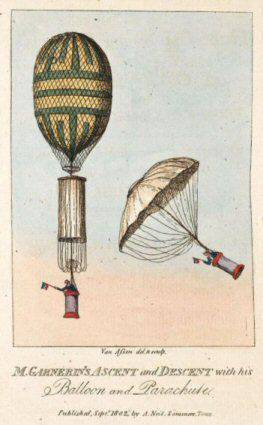 Once he saw an aerostat in the sky, Cocking forever “fell ill” with this romantic act. The most vivid impression left in the memory of Cocking is the first in England demonstration parachute jump, which 21 made on September 1802. Famous French aeronaut and the world's first parachutist Andre-Jacques Garnerin. The keen eye of the artist and researcher had already discovered a serious problem that Garnerin’s parachute was subject to during descent, the dangerous swinging and uncontrolled rotation of the parachute canopy. Despite the fact that the parachute design has undergone a significant evolution since the first jump of Garnerin in 1797, the unstable behavior of the device in the air could not be eliminated, which posed a real threat to the life of the parachutists.
Once he saw an aerostat in the sky, Cocking forever “fell ill” with this romantic act. The most vivid impression left in the memory of Cocking is the first in England demonstration parachute jump, which 21 made on September 1802. Famous French aeronaut and the world's first parachutist Andre-Jacques Garnerin. The keen eye of the artist and researcher had already discovered a serious problem that Garnerin’s parachute was subject to during descent, the dangerous swinging and uncontrolled rotation of the parachute canopy. Despite the fact that the parachute design has undergone a significant evolution since the first jump of Garnerin in 1797, the unstable behavior of the device in the air could not be eliminated, which posed a real threat to the life of the parachutists.Since then, the noble idea to make happy the brave explorers of the air of the ocean firmly stuck in the head of our hero with a reliable means of salvation. Years passed, but the right idea never came to Cocking's mind. Suddenly, he came across an article by an English scientist and inventor George Kaylee, published in 1809 in the collection On Air Navigation, in which he argued, based on exact mathematical calculations, that the parachute movement can be stabilized by giving it the shape of a reverse cone facing top down. By the way, Kaylee also observed Garnerin’s jump in 1802, and, just like Cocking, noted the unstable behavior of his parachute in the air. And it was precisely this circumstance that gave Kaylie the reason for theoretical studies of the problems of stabilizing the movement of a parachute. Kokking thoroughly studied the material of the article and was inspired by the logic and accuracy of the mathematical calculations of the scientist. All subsequent years, he constantly returned to this idea, carefully and progressively, step by step, working through the design of the future parachute.
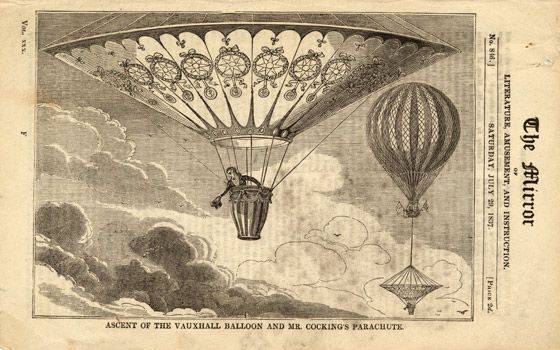
The experiments that he conducted with the models of the "inverted" parachute, dropping them from various tall buildings in London, as well as from small balloons, convinced Kokking in the correctness of the chosen idea and design: the parachutes quite stably and consistently behaved in the air. The idea of an "inverted cone" pursued Cocking for many years, not abandoning the hope of fulfilling, in the end, an "life-size" experiment.
After many years, when he was already at the age of sixty, Cocking met and became friends with the first English aeronaut, James Sadler, with whom he performed one balloon flight. The world opened from a bird's eye view filled the romantic soul of the artist with vivid sensations and with a new force recalled the cherished idea and dream. In 1835, Cocking became close to Frederick Guy, owner of Vauxhall Gardens in London, who was passionate about aeronautics and often organized aerostat performances for the venerable public. Sensing a “soul mate” in Guy, Cocking laid out his idea to him and asked for help in its practical implementation. Guy, having understood the essence of the parachute design and not wanting to participate in this adventurous undertaking, decisively refused. At the same time, the owners of the park began financing the manufacture of a large aerostat, named Vauxhall Gardens (later renamed Nassau), and intended for long-haul flights to Germany in 1836. To implement this record flight at the time, the famous aeronaut Charles Green was invited. Cocking quickly realized that there was a chance for him to realize his dream, and he actively plunged into the exciting atmosphere of preparing for the flight, helping Green in every way in solving organizational issues. Cocking's “disinterested” help was not ignored, and in gratitude for this 27 September 1836 of Mr. Green took him with him on one of the training flights, during which Cocking did not fail to mention his idea. Green, being very busy on the eve of a long-distance flight, complacently promised Koking to watch his parachute after the flight to Germany.
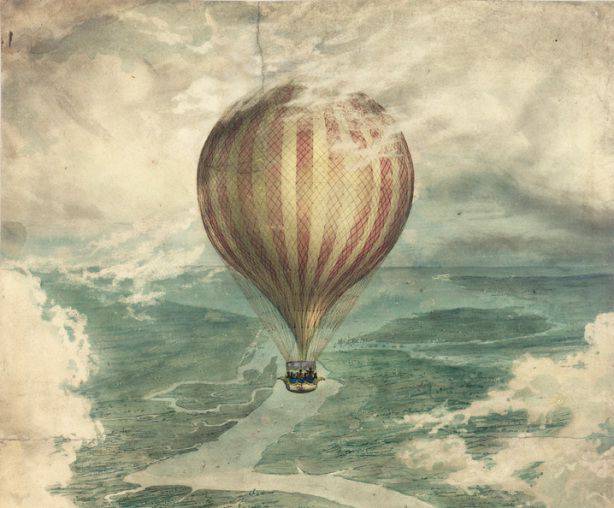
Returning from Germany, Green carefully read the design of the parachute and gave a positive review. With such a strong argument in hand, Cocking stepped up pressure on Frederick Guy and his companion Richard Hughes and, in the end, received the long-awaited funding for the project. According to the contract, the original of which is still stored in London, Cocking received money for the construction of a parachute, Vauxhall Gardens provided production space, the first descent was made without payment of remuneration, the next two were paid for 20 guineas, and for all subsequent 30 guineas. Throwing all doubts and current affairs aside, Cocking began the practical implementation of his many years of theoretical research.
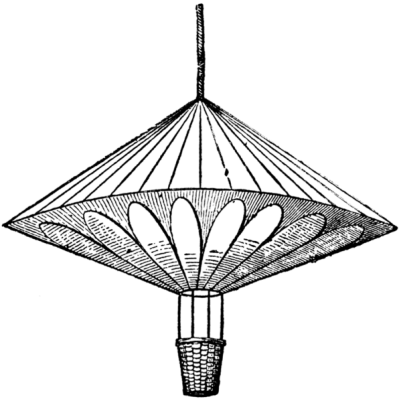 The design of the apparatus was an inverted truncated cone with a height of 3 and angle of inclination of the side wall of 30 degrees. The upper rim of the cone was made of a tin pipe with a diameter of 10 m. The lower rim and intermediate were made of copper. Between the rims were connected by ten wooden planks, and the whole design is covered with richly decorated dense Irish fabric with an area of 103 square. A basket woven from wicker rods was hung to the lower rim on the lines. The weight of the parachute, according to most sources, was 101 kg. Calculations showed that the rate of descent of the apparatus was to be 3 m / s.
The design of the apparatus was an inverted truncated cone with a height of 3 and angle of inclination of the side wall of 30 degrees. The upper rim of the cone was made of a tin pipe with a diameter of 10 m. The lower rim and intermediate were made of copper. Between the rims were connected by ten wooden planks, and the whole design is covered with richly decorated dense Irish fabric with an area of 103 square. A basket woven from wicker rods was hung to the lower rim on the lines. The weight of the parachute, according to most sources, was 101 kg. Calculations showed that the rate of descent of the apparatus was to be 3 m / s.By Monday 24 July 1837, everything was ready for flight. On the eve of all the direct participants in the project came together to once again discuss the details of the upcoming event. The atmosphere of the meeting was far from enthusiastic - there was clearly anxiety in the air for the safe outcome of this risky event. Frederick Guy, pale with excitement, appealed to Cockering for the last time to evaluate all the risks associated with the experiment, carefully consider the internal sense of the correctness of the chosen design solutions, based on the experience gained during the construction, evaluate the state of the nervous system, and if there is If the slightest doubt in the favorable end of the experiment, then, of course, refuse to carry it out. Guy assured Cocking that any of his decisions would be adequately appreciated by everyone present, no one doubts the determination and personal courage of the 60-year-old author of the project, but none of the participants in this action would like to subject the respected inventor to unnecessary risk.
Cocking thanked those present for their assistance in the implementation of his project, and assured that he was fully prepared to perform the jump, and was confident in his successful outcome. At the same time, he demonstrated to all the last recall of a group of famous scientists on the construction of a parachute, which confirmed the correctness of his calculations. During the discussion of the details of the technical procedures of the experiment, Green, who was supposed to fly a parachute balloon, refused to unhook the line on which the parachute was suspended, explaining this decision by the fact that it was Kokking who should have the last chance to give up the jump .
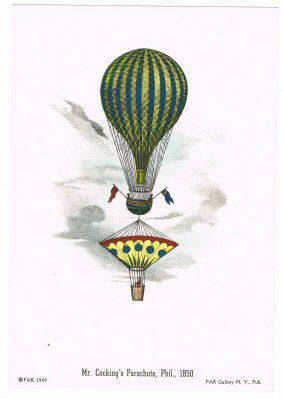 On the evening of 7.35, when the wind and the atmosphere calmed down after daytime temperature drops, with a huge crowd of spectators, Green and his assistant, Spencer, climbed into the balloon basket. The ground crew led the balloon to the parachute and picked it up. Cocking, demonstrating an enviable calm, to the cheers of the spectators, sat down in a parachute basket. After a short conversation with Cocking, during which the procedure in the air was again specified and clarified, Green gave the command to release the ropes, and the balloon majestically went up. From the crowd came numerous cries with wishes of good luck and a safe return to earth. Cocking, still maintaining complete composure, smiled in response and waved his hand in greeting. And here there was a slight nuisance - one of the ropes hooked on a special sleeve, on which it was supposed to throw ballast from the balloon, bypassing the parachute dome, and cut it off. Green considered that there was no disaster in it, and continued to rise.
On the evening of 7.35, when the wind and the atmosphere calmed down after daytime temperature drops, with a huge crowd of spectators, Green and his assistant, Spencer, climbed into the balloon basket. The ground crew led the balloon to the parachute and picked it up. Cocking, demonstrating an enviable calm, to the cheers of the spectators, sat down in a parachute basket. After a short conversation with Cocking, during which the procedure in the air was again specified and clarified, Green gave the command to release the ropes, and the balloon majestically went up. From the crowd came numerous cries with wishes of good luck and a safe return to earth. Cocking, still maintaining complete composure, smiled in response and waved his hand in greeting. And here there was a slight nuisance - one of the ropes hooked on a special sleeve, on which it was supposed to throw ballast from the balloon, bypassing the parachute dome, and cut it off. Green considered that there was no disaster in it, and continued to rise.On the eve of the ascent, Green and Cocking agreed that the parachute would be disconnected from the balloon at 2500 m height. According to Kokking, “the greater the distance to the ground, the greater the air pressure under the parachute during descent, and therefore the descent will be easier and safe. " Some time after the start, Green noticed that the speed of the aerostat was clearly less than the required one, and ordered Spencer to reset part of the ballast. For a short time, the lifting speed increased, but then began to fall again - the balloon was clearly overweight. Green realized that it would not be possible to reach the required height before darkness — the balloon was very heavy, and the inverse conical shape of the parachute did its bit to reduce the ascent rate. Further consumption of ballast threatened a great danger during landing. The situation was aggravated by the approaching twilight. The barometer on board the balloon showed the pressure corresponding to the height of 1500 m. After a brief meeting with Spencer Green, he decided to discuss the problem with Cocking. He instantly assessed the problem, and expressed willingness to start immediately. After a short reflection, Green agreed and asked Cocking about his state of health and mood. In response, he cheerfully shouted that he was fine, he was confident of himself, and in conclusion, wished his friends good night.
The next second, Green and Spencer felt a short jerk, but nothing happened, the balloon was calmly floating in the air ... Another jerk, an unknown force knocked the aeronaut down and threw the basket to the bottom ... The balloon, freed from parachute with Cocking, rushed upwards with tremendous speed , spewing out a cloud of hydrogen from the upper valve and the lower filling appendix. There was a real threat of rupture of the balloon shell. Under the influence of a huge overload, the slings of the basket suspension system began to break, it was dangerously tilted. Squeezed by strong acceleration to the bottom of the basket and shrouded in hydrogen, the aeronautists began to choke on the lack of oxygen. The situation was aggravated by a layer of clouds, into which a balloon was thrust, plunging everything around into dense darkness. With an incredible effort of will, on the remnants of consciousness, Spencer managed to reach the flexible tubes of clean air cylinders - this was a salvation. Soon the rate of ascent decreased, Green and Spencer slowly came to their senses from what they had experienced, and a thick cloud of clouds spread around the horizon. A large loss of carrier gas and a damaged basket suspension system promised a difficult landing, and the coming darkness did not add to mood ... However, Green’s vast experience as an aeronaut was a significant guarantee of the success of the upcoming landing. Close to midnight, they sat down.
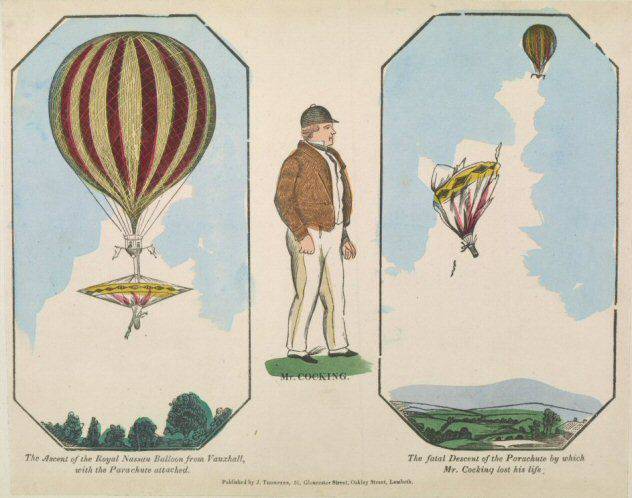
Professor Airy of the Greenwich Observatory, seeing a rising balloon through the window, called his wife and children to the window and aimed a small telescope at him, studying with interest the device of an incomprehensible design hooked to the balloon basket. There was no end to his surprise when he discovered a man hanging from this device. The balloon smoothly gained altitude and, illuminated by the rays of the setting sun, was clearly visible against the background of clouds. Suddenly, to the indescribable fright of the professor and his family, the device separated from the balloon and went down. For a few seconds everything was fine - the device was falling vertically, but suddenly it was suddenly formed, spun, turned into a shapeless room with details of the construction scattering in all directions and throwing cloth panels. Half a minute of fall, and the remains of the apparatus disappeared behind the trees. The professor was shocked, his wife and children were crying ...
A similar picture was also observed by Mr. Underwood, on horseback from the moment of launch, the accompanying flight of the balloon. Having determined the direction of the fall of the parachute, he spurred his horse and was soon at the site of the tragedy. On the field, where the parachute fell, already several peasants fussed. Underwood promised five guineas to the one who first finds a person who should be among these fragments. Soon, lifeless, entangled in the wreckage of a parachute, Cocking was discovered. He was carried to the nearest inn, where the arriving doctor stated the death from numerous injuries on the body. All fragments of a parachute were also demolished there. The owner of the tavern, a smart guy, quickly realized that you can make good money at this tragic event. For three pence, he organized a demonstration for the local residents of the parachute fragments, and for six pence - the body of the unfortunate Cocking.
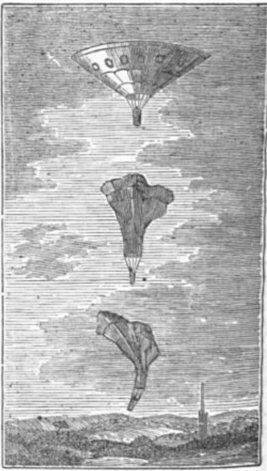 Meanwhile, in scientific circles and the press there was a discussion about the causes of the tragedy. In addition to the fact that the idea of the inverted cone itself was of reasonable concern to many scientists, Koking’s use of the tin rim in the parachute’s power structure was considered to be clearly erroneous. Cocking himself was convinced of the opposite, and when he was told that the hoops needed to be made more durable, he replied: "Do not let me weight the structure of the parachute." The commission set up to investigate this tragic incident came to the unexpected conclusion that Cocking, at the last moment, introduced controls into the parachute design, which could change the direction of descent by changing the geometry of the cone.
Meanwhile, in scientific circles and the press there was a discussion about the causes of the tragedy. In addition to the fact that the idea of the inverted cone itself was of reasonable concern to many scientists, Koking’s use of the tin rim in the parachute’s power structure was considered to be clearly erroneous. Cocking himself was convinced of the opposite, and when he was told that the hoops needed to be made more durable, he replied: "Do not let me weight the structure of the parachute." The commission set up to investigate this tragic incident came to the unexpected conclusion that Cocking, at the last moment, introduced controls into the parachute design, which could change the direction of descent by changing the geometry of the cone. The version of the tragedy that was put forward before the commission by Frederick Guy turned out to be very convincing. He, together with the doctors, took part in the examination of Cocking's body. Experts noticed a deep, even cut around the broken wrist of his left hand. An analysis of the reasons for the appearance of this cut led to an unexpected conclusion - with this hand, with a strong rope, Cocking opened the hook hook that fastened the parachute to the balloon. Events, according to Guy, developed as follows. Having decided to unhook from the aerostat, Cocking pulled the rope opening the hook (Green and Spencer felt the first jerk). The efforts of this breakthrough were not enough, the hook did not open. Cocking realized that he needed to tear the rope with all his might, and so that the rope did not slip out of his hand, he threw it around his wrist. After the hook opened, and the parachute fell down, Cocking did not have time to release his hand and hung on the rope sweeping around his wrist. The falling parachute covered Cocking and he, having flown inside the apparatus, crushed the entire power part of the structure. Under the weight of the apparatus, the rope broke and the parachute, which lost its structural stability, began to fall apart in a fall ...
Robert Cocking is buried near the place of his tragic death, in the Church of St. Margaret near Greenwich Observatory. His death was the first tragedy in the history of parachuting. His act cannot be explained in terms of human logic and simple pragmatism. Such acts are made only by the zealous idealists, who recklessly believe in the limitless possibilities of the human mind.
And the last. American aeronaut John Wiz did a series of experiments with the parachutes of the Garner and Cocking systems, and made sure that the latter behaved much more stable, usually spiraling down. By the way, the same Wiz conducted a deadly experiment to prove that the shell of the balloon when a large amount of gas was lost during descent at high speed takes the shape of a parachute dome, thereby reducing this speed to a safe one.
Information